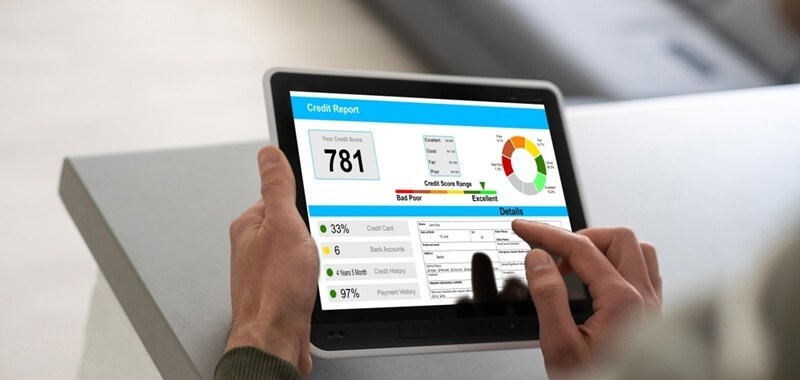
Understanding how your credit score is calculated is one of the most crucial steps to achieving financial freedom and stability. Your credit score is important for being accepted for a loan, determining your interest rate, and even qualifying for an apartment rental. Within the first 100 words, let's get this straight—what credit scores are based on is more than one credit score factor, such as your payment history effect and your credit utilization ratio. Combined, these factors form the basis of your credit well-being and help lenders determine your trustworthiness as a borrower.
This detailed manual will dissect the factors that affect credit scores, define the differences between Vantage Score and FICO, and inform you of the factors that impact credit scores, so that you can confidently master your financial future.
Before you can enhance your credit, it's helpful to know how credit scores are calculated and what the numbers really mean. Your credit score is a three-digit number—usually between 300 and 850—that informs lenders whether you will pay borrowed funds responsibly or not.
Two significant scoring models, FICO and Vantage Score, reign supreme in the industry. Although both measure the same credit score indicators, they preferentially weigh them somewhat differently. FICO scores are utilized by approximately 90% of key lenders, while VantageScore has gained popularity among free credit tracking tools and some newer financial entities.
Either way, your credit score is based on a review of data in your credit report, which is kept by the three major credit bureaus: TransUnion, Experian, and Equifax. Here are the main elements that determine your credit score.
All credit scoring models use a set of foundational elements, or credit score factors, that together determine your score. As the percentages between FICO and Vantage Score may differ, the following categories are universally accepted as essential to understanding how credit scores work.

Your payment history is the most important component in your credit score calculation. It represents approximately 35% of your overall score in the FICO system. Your lender would like to know whether you pay bills on time, whether late or missed payments remain on your credit report for as long as seven years.
Even one late payment can damage your score, particularly if you're establishing credit. Be consistent: pay at least the minimum on time, every time.
Pro Tip: Automate payments or set reminders so you never forget a due date.
Your credit utilization ratio measures how much of your available credit you’re using at any given time. It’s one of the most influential credit score factors and can have a huge effect on what affects the credit score overall.
For instance, when you have a total credit limit of $10,000 and have $3,000 outstanding, your utilization ratio is 30%. Experts suggest that this ratio be kept below 30% for maximum effect, though less than 10% is preferred if you want to improve your score in a hurry.
A low ratio indicates to lenders that you handle credit well without depending too much on borrowed money.
The longer your credit history, the more it speaks about your reliability as a borrower. Lenders want applicants to have a track record of paying accounts over several years.
Opening too many new accounts within a short time can reduce the average age of your credit history, potentially damaging your score.
Each time you apply for a new loan or credit card, lenders conduct a hard search of your credit report. Amassing too many inquiries within a short period may affect your score negatively in the short run, as it may imply you are in financial distress.
Minimize the impact by using credit wisely.
Getting a mix of credit types - credit cards, car loans, mortgages, etc. - will help raise your score. Lenders want to see that you have successfully managed different types of credit. However, don't open up new accounts just to get the mix. Simply focus on managing the accounts you currently have.
Both models (FICO and Vantage Score) assess your financial habits, but there are several key points to consider. Knowing these differences is interesting and will help you better understand your score and maintain it for long-term use.
Although FICO and VantageScore use very similar bases, the impacts of the individual factors that make up the credit scores are prioritized slightly differently. For example, VantageScore places a greater emphasis on recent credit activity, while FICO places a heavier emphasis on long-term credit history. Keeping this in mind will assist your understanding of calculations for credit scores for each model.
When you find out what affects credit scores, you have the knowledge necessary to make informed decisions about how to protect and improve your finances.
The most significant factors are:
Tip: You’re entitled to one free credit report every year from each of the three credit bureaus via AnnualCreditReport.com.
Your payment history impact extends beyond just credit cards—it includes loans, mortgages, and even some utility bills. A history of timely payments shows you are a dependable borrower and works to your advantage with lenders.
If you have previously dealt with late payments, don't despair. Time will diminish the influence of older negative remarks (particularly if you establish a pattern of on-time payments.)
While people focus on making bill payments on time, they often overlook the credit utilization ratio, a significant factor that contributes to how credit scores are calculated. High credit utilization—even with the best payment history—will lower your score because it gives the impression that you have an excessive use of credit.
Ways to Improve Your Credit Utilization Ratio:
Maintaining a utilization rate of less than 30%, or preferably under 10%, can result in a noticeable and rapid increase in your score.
If you want to improve your credit, begin your improvement by focusing on the factors that affect your credit score the most.
1. Make On-Time Payments: Set reminders on your calendar or set up auto-payments.
2. Lower Your Credit Utilization Amount: Lower your revolving balances consistently.
3. Don't Open Too Many New Accounts: If you are opening new credit accounts and being requested for credit inquiries, spread apart those inquiries for 6 months or more.
4. Keep Old Accounts Open: Closing an account can negatively reduce your credit history and lower your score.
5. Review Your Report Regularly & Dispute Any Errors Promptly: Be sure your score is reflective of your factual behavior and report any potential errors promptly.
Both models assist lenders in assessing risk; however, most lenders still use FICO scores because FICO has been around for a longer period of time than VantageScore. However, more lenders are beginning to consider VantageScore because it calculates quickly for individuals with shorter or thinner credit histories.
For instance, if you've just opened your first credit card account, your VantageScore might surface earlier than your FICO score. However, a low credit utilization percentage and regular on-time payments are favorable for both scoring models.
Understanding how credit scores are calculated is not only about improving numbers; it is about long-term financial autonomy. A better credit score could mean:
By being aware of the factors that influence credit score, such as payment history influence and credit utilization percentage, you will prepare yourself for long-term financial opportunities.
There are a few myths commonly held about what impacts your credit score.
Let's dispel a few:
False. Soft checks (such as looking up your own score) don't impact your credit.
False. Closing cards can harm your credit utilization ratio and shorten your credit history.
False. Paying in full shows responsible behavior and avoids interest charges.
False. Installment loans and revolving credit are handled differently, particularly in FICO vs VantageScore versions.
Knowing how credit scores are calculated gives you the power to manage your financial well-being. By focusing on the basic components that impact your credit profile, namely payment history, credit utilization ratio, and understanding the differences between FICO and VantageScore, you're making conscious decisions to develop and maintain a good credit profile.
A good credit report is not a decision once made; it is a behavior, a habit, a commitment to ongoing success for your entire life. You can start by taking small and deliberate actions, while being patient and caring, and making well-informed decisions on credit usage, and ultimately, your well-informed habits will achieve a good score, so that you can experience the financial opportunities that you are entitled to.
This content was created by AI